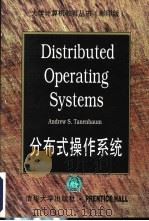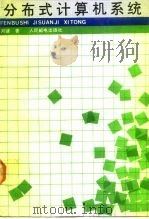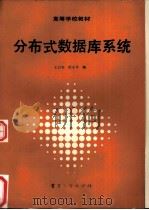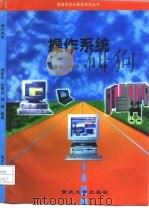《分布式操作系统》
| 作者 | (美)(A.S.塔嫩鲍姆)Andrew S.Tanenbau 编者 |
|---|---|
| 出版 | 北京:清华大学出版社 |
| 参考页数 | 614 |
| 出版时间 | 1997(求助前请核对) 目录预览 |
| ISBN号 | 7302024111 — 求助条款 |
| PDF编号 | 81965478(仅供预览,未存储实际文件) |
| 求助格式 | 扫描PDF(若分多册发行,每次仅能受理1册) |

1 INTRODUCTION TO DISTRIBUTED SYSTEMS1
1.1 WHAT IS A DISTRIBUTED SYSTEM?2
1.2 GOALS3
1.2.1 Advantages of Distributed Systems over Centralized Systems3
1.2.2 Advantages of Distributed Systems over Independent PCs6
1.2.3 Disadvantages of Distributed Systems6
1.3 HARDWARE CONCEPTS8
1.3.1 Bus-Based Multiprocessors10
1.3.2 Switched Multiprocessors12
1.3.3 Bus-Based Multicomputers13
1.3.4 Switched Multicomputers14
1.4 SOFTWARE CONCEPTS15
1.4.1 Network Operating Systems16
Contents16
PREFACE 16
1.4.2 True Distributed Systems18
1.4.3 Multiprocessor Timesharing Systems20
1.5.1 Transparency22
1.5 DESIGN ISSUES22
1.5.2 Flexibility25
1.5.3 Reliability27
1.5.4 Performance28
1.5.5 Scalability29
1.6 SUMMARY31
2 COMMUNICATION IN DISTRIBUTED SYSTEMS34
2.1 LAYERED PROTOCOLS35
2.1.2 The Data Link Layer38
2.1.1 The Physical Layer38
2.1.3 The Network Layer40
2.1.4 The Transport Layer40
2.1.5 The Session Layer41
2.1.6 The Presentation Layer41
2.1.7 The Application Layer42
2.2 ASYNCHRONOUS TRANSFER MODE NETWORKS42
2.2.1 What Is Asynchronous Transfer Mode?42
2.2.2 The ATM Physical Layer44
2.2.3 The ATM Layer45
2.2.4 The ATM Adaptation Layer46
2.2.5 ATM Switching47
2.2.6 Some Implications of ATM for Distributed Systems49
2.3 THE CLIENT-SERVER MODEL50
2.3.1 Clients and Servers51
2.3.2 An Example Client and Server52
2.3.3 Addressing56
2.3.4 Blocking versus Nonblocking Primitives58
2.3.5 Buffered versus Unbuffered Primitives61
2.3.6 Reliable versus Unreliable Primitives63
2.3.7 Implementing the Client-Server Model65
2.4 REMOTE PROCEDURE CALL68
2.4.1 Basic RPC Operation68
2.4.2 Parameter Passing72
2.4.3 Dynamic Binding77
2.4.4 RPC Semantics in the Presence of Failures80
2.4.5 Implementation Issues84
2.4.6 Problem Areas95
2.5.1 Introduction to Group Communication99
2.5 GROUP COMMUNICATION99
2.5.2 Design Issues101
2.5.3 Group Communication in ISIS110
2.6 SUMMARY114
3 SYNCHRONIZATION IN DISTRIBUTED SYSTEMS118
3.1 CLOCK SYNCHRONIZATION119
3.1.1 Logical Clocks120
3.1.2 Physical Clocks124
3.1.3 Clock Synchronization Algorithms127
3.1.4 Use of Synchronized Clocks132
3.2 MUTUAL EXCLUSION134
3.2.1 A Centralized Algorithm134
3.2.2 A Distributed Algorithm135
3.2.3 A Token Ring Algorithm138
3.2.4 A Comparison of the Three Algorithms139
3.3 ELECTION ALGORITHMS140
3.3.1 The Bully Algorithm141
3.3.2 A Ring Algorithm143
3.4.1 Introduction to Atomic Transactions144
3.4 ATOMIC TRANSACTIONS144
3.4.2 The Transaction Model145
3.4.3 Implementation150
3.4.4 Concurrency Control154
3.5 DEADLOCKS IN DISTRIBUTED SYSTEMS158
3.5.1 Distributed Deadlock Detection159
3.5.2 Distributed Deadlock Prevention163
3.6 SUMMARY165
4.1 THREADS169
4 PROCESSES AND PROCESSORS IN DISTRIBUTED SYSTEMS169
4.1.1 Introduction to Threads170
4.1.2 Thread Usage171
4.1.3 Design Issues for Threads Packages174
4.1.4 Implementing a Threads Package178
4.1.5 Threads and RPC184
4.2 SYSTEM MODELS186
4.2.1 The Workstation Model186
4.2.2 Using Idle Workstations189
4.2.3 The Processor Pool Model193
4.2.4 AHybridModel197
4.3 PROCESSOR ALLOCATION197
4.3.1 Allocation Models197
4.3.2 Design Issues for Processor Allocation Algorithms199
4.3.3 Implementation Issues for Processor Allocation Algorithms201
4.3.4 Example Processor Allocation Algorithms203
4.4 SCHEDULING IN DISTRIBUTED SYSTEMS210
4.5.1 Component Faults212
4.5 FAULT TOLERANCE212
4.5.2 System Failures213
4.5.3 Synchronous versus Asynchronous Systems214
4.5.4 Use of Redundancy214
4.5.5 Fault Tolerance Using Active Replication215
4.5.6 Fault Tolerance Using Primary-Backup217
4.5.7 Agreement in Faulty Systems219
4.6 REAL-TIME DISTRIBUTED SYSTEMS223
4.6.1 What Is a Real-Time System?223
4.6.2 Design Issues226
4.6.3 Real-Time Communication230
4.6.4 Real-Time Scheduling234
4.7 SUMMARY240
5 DISTRIBUTED FILE SYSTEMS245
5.1 DISTRIBUTED FILE SYSTEM DESIGN246
5.1.1 The File Service Interface246
5.1.2 The Directory Server Interface248
5.1.3 Semantics of File Sharing253
5.2 DISTRIBUTED FILE SYSTEM IMPLEMENTATION256
5.2.1 File Usage256
5.2.2 System Structure258
5.2.3 Caching262
5.2.4 Replication268
5.2.5 An Example:Sun's Network File System272
5.2.6 Lessons Learned278
5.3 TRENDS IN DISTRIBUTED FILE SYSTEMS279
5.3.1 New Hardware280
5.3.2 Scalability282
5.3.3 Wide Area Networking283
5.3.5 Fault Tolerance284
5.3.4 Mobile Users284
5.3.6 Multimedia285
5.4 SUMMARY285
6 DISTRIBUTED SHARED MEMORY289
6.1 INTRODUCTION290
6.2 WHAT IS SHARED MEMORY?292
6.2.1 On-Chip Memory293
6.2.2 Bus-Based Multiprocessors293
6.2.3 Ring-Based Multiprocessors298
6.2.4 Switched Multiprocessors301
6.2.5 NUMA Multiprocessors308
6.2.6 Comparison of Shared Memory Systems312
6.3 CONSISTENCY MODELS315
6.3.1 Strict Consistency315
6.3.2 Sequential Consistency317
6.3.3 Causal Consistency321
6.3.4 PRAM Consistency and Processor Consistency322
6.3.5 Weak Consistency325
6.3.6 Release Consistency327
6.3.7 Entry Consistency330
6.3.8 Summary of Consistency Models331
6.4 PAGE-BASED DISTRIBUTED SHARED MEMORY333
6.4.1 Basic Design334
6.4.2 Replication334
6.4.3 Granularity336
6.4.4 Achieving Sequential Consistency337
6.4.5 Finding the Owner339
6.4.6 Finding the Copies342
6.4.7 Page Replacement343
6.4.8 Synchronization344
6.5 SHARED-VARIABLE DISTRIBUTED SHARED MEMORY345
6.5.1 Munin346
6.5.2 Midway353
6.6 OBJECT-BASED DISTRIBUTED SHARED MEMORY356
6.6.1 Objects356
6.6.2 Linda358
6.6.3 Orca365
6.7 COMPARISON371
6.8 SUMMARY372
7 CASE STUDY 1:AMOEBA376
7.1 INTRODUCTION TO AMOEBA376
7.1.1 History of Amoeba376
7.1.2 Research Goals377
7.1.3 The Amoeba System Architecture378
7.1.4 The Amoeba Microkernel380
7.1.5 The Amoeba Servers382
7.2.1 Capabilities384
7.2 OBJECTS AND CAPABILITIES IN AMOEBA384
7.2.2 Obiect Protection385
7.2.3 Standard Operations387
7.3 PROCESS MANAGEMENT IN AMOEBA388
7.3.1 Processes388
7.3.2 Threads391
7.4 MEMORY MANAGEMENT IN AMOEBA392
7.4.1 Segments392
7.4.2 Mapped Segments393
7.5 COMMUNICATION IN AMOEBA393
7.5.1 Remote Procedure Call394
7.5.2 Group Communication in Amoeba398
7.5.3 The Fast Local Internet Protocol407
7.6 THE AMOEBA SERVERS415
7.6.1 The Bullet Server415
7.6.2 The Directory Server420
7.6.3 The Replication Server425
7.6.4 The Run Server425
7.6.6 The TCP/IP Server427
7.6.5 The Boot Server427
7.6.7 Other Servers428
7.7 SUMMARY428
8 CASE STUDY 2:MACH431
8.1 INTRODUCTION TO MACH431
8.1.1 History of Mach431
8.1.2 Goals of Mach433
8.1.3 The Mach Microkernel433
8.1.4 The Mach BSD UNIX Server435
8.2.1 Processes436
8.2 PROCESS MANAGEMENT IN MACH436
8.2.2 Threads439
8.2.3 Scheduling442
8.3 MEMORY MANAGEMENT IN MACH445
8.3.1 Virtual Memory446
8.3.2 Memory Sharing449
8.3.3 External Memory Managers452
8.3.4 Distributed Shared Memory in Mach456
8.4.1 Ports457
8.4 COMMUNICATION IN MACH457
8.4.2 Sending and Receiving Messages464
8.4.3 The Network Message Server469
8.5 UNIX EMULATION IN MACH471
8.6 SUMMARY472
9 CASE STUDY 3:CHORUS475
9.1 INTRODUCTION TO CHORUS475
9.1.1 History of Chorus476
9.1.2 Goals of Chorus477
9.1.3 System Structure478
9.1.4 Kernel Abstractions479
9.1.5 Kernel Structure481
9.1.6 The UNIX Subsystem483
9.1.7 The Object-Oriented Subsystem483
9.2 PROCESS MANAGEMENT IN CHORUS483
9.2.1 Processes484
9.2.2 Threads485
9.2.3 Scheduling486
9.2.4 Traps,Exceptions,and Interrupts487
9.2.5 Kernel Calls for Process Management488
9.3 MEMORY MANAGEMENT IN CHORUS490
9.3.1 Regions and Segments490
9.3.2 Mappers491
9.3.3 Distributed Shared Memory492
9.3.4 Kernel Calls for Memory Management493
9.4 COMMUNICATON IN CHORUS495
9.4.1 Messages495
9.4.2 Ports495
9.4.3 Communication Operations496
9.4.4 Kernel Calls for Communication498
9.5 UNIX EMULATION IN CHORUS499
9.5.1 Structure of a UNIX Process500
9.5.2 Extensions to UNIX500
9.5.3 Implementation of UNIX on Chorus501
9.6 COOL:AN OBJECT-ORIENTED SUBSYSTEM507
9.6.1 The COOL Architecture507
9.6.2 The COOL Base Layer507
9.6.3 The COOL Generic Runtime System509
9.6.4 The Language Runtime System509
9.7 COMPARISON OF AMOEBA,MACH,AND CHORUS510
9.6.5 Implementation of COOL510
9.7.1 Philosophy511
9.7.2 Obiects512
9.7.3 Processes513
9.7.4 Memory Model514
9.7.5 Communication515
9.7.6 Servers516
9.8 SUMMARY517
10.1.1 History of DCE520
10 CASE STUDY 4:DCE520
10.1 INTRODUCTION TO DCE520
10.1.2 Goals of DCE521
10.1.3 DCE Components522
10.1.4 Cells525
10.2 THREADS527
10.2.1 Introduction to DCE Threads527
10.2.2 Scheduling529
10.2.3 Synchronization530
10.2.4 Thread Calls531
10.3 REMOTE PROCEDURE CALL535
10.3.1 Goals of DCE RPC535
10.3.2 Writing a Client and a Server536
10.3.3 Binding a Client to a Server538
10.3.4 Performing an RPC539
10.4 TIME SERVICE540
10.4.1 DTS Time Model541
10.4.2 DTS Implementation543
10.5 DIRECTORY SERVICE544
10.5.1 Names546
10.5.2 The Cell Directory Service547
10.5.3 The Global Directory Service549
10.6 SECURITY SERVICE554
10.6.1 Security Model555
10.6.2 Security Components557
10.6.3 Tickets and Authenticators558
10.6.4 Authenticated RPC559
10.6.5 ACLs562
10.7 DISTRIBUTED FILE SYSTEM564
10.7.1 DFS Interface565
10.7.2 DFS Components in the Server Kernel566
10.7.3 DFS Components in the Client Kernel569
10.7.4 DFS Components in User Space571
10.8 SUMMARY573
11 BIBLIOGRAPHY AND SUGGESTED READINGS577
11.1 SUGGESTED READINGS577
11.2 ALPHABETICAL BIBLIOGRAPHY584
INDEX603
1997《分布式操作系统》由于是年代较久的资料都绝版了,几乎不可能购买到实物。如果大家为了学习确实需要,可向博主求助其电子版PDF文件(由(美)(A.S.塔嫩鲍姆)Andrew S.Tanenbau 1997 北京:清华大学出版社 出版的版本) 。对合法合规的求助,我会当即受理并将下载地址发送给你。
高度相关资料
-

- 分布式计算机系统
- 1990 北京:人民邮电出版社
-

- 分布式数据库系统
- 1988
-

- Authorware 6 完全教程
- 人民邮电出版社
-

- 分布式系统与分布式算法
- 1995 广州:暨南大学出版社
-

- 分布式计算机系统
- 1991 北京希望电脑公司
-

- 分布式计算机系统
- 1987 北京:国防工业出版社
-

- 分布式处理系统
- 1987 北京:科学出版社
-

- 操作系统
- 1980 北京:科学出版社
-

- 分布式操作系统设计
- 1993 北京:海洋出版社
-

- 操作系统
- 1997 重庆:重庆大学出版社
-

- 分布式计算机系统
- 1986 北京:科学技术文献出版社
-

- 操作系统
- 1993 北京:科学出版社
-

- 计算机文化基础
- 1999 哈尔滨:哈尔滨工程大学出版社
-

- 操作系统
- 1996 天津:南开大学出版社
提示:百度云已更名为百度网盘(百度盘),天翼云盘、微盘下载地址……暂未提供。➥ PDF文字可复制化或转WORD
